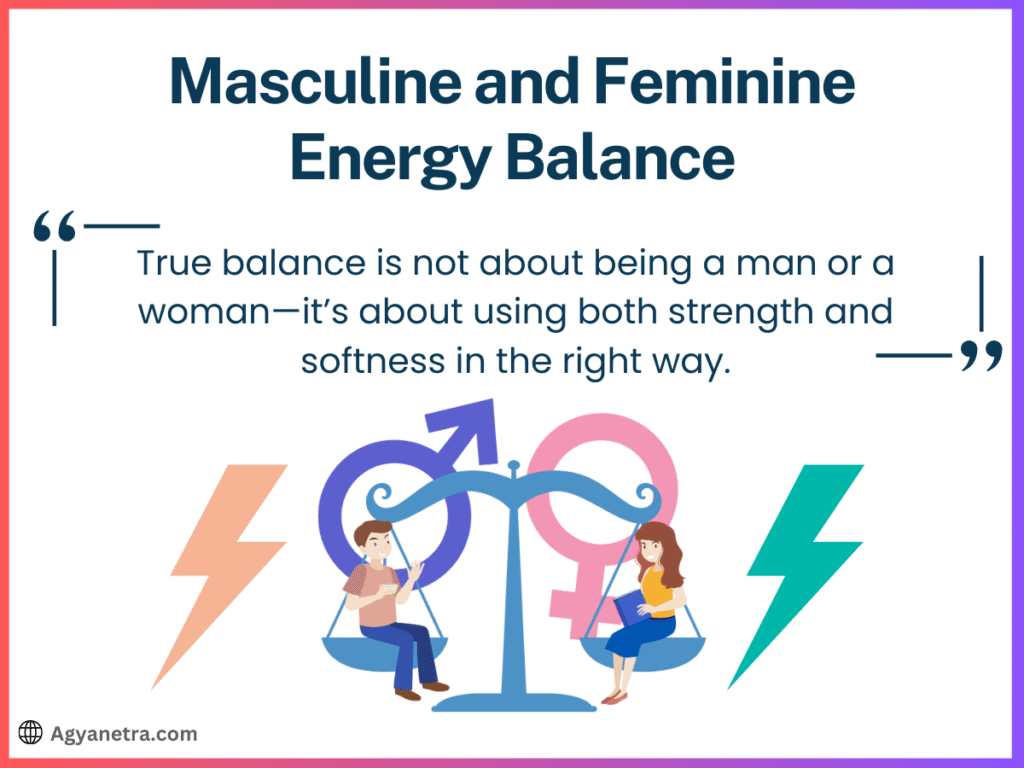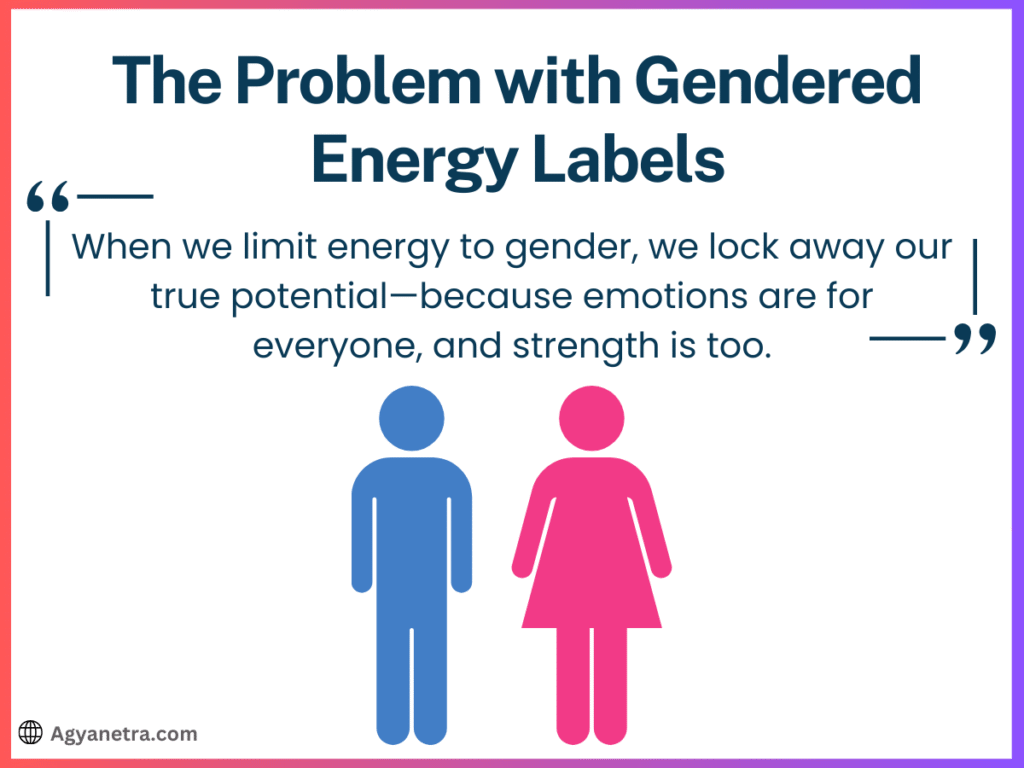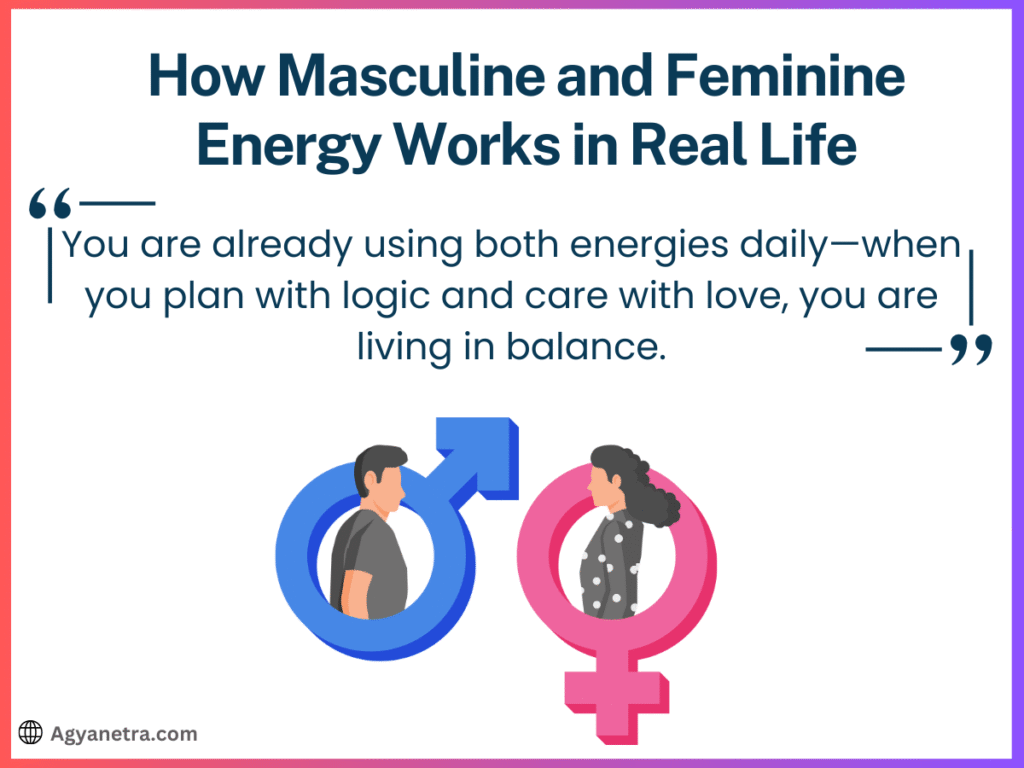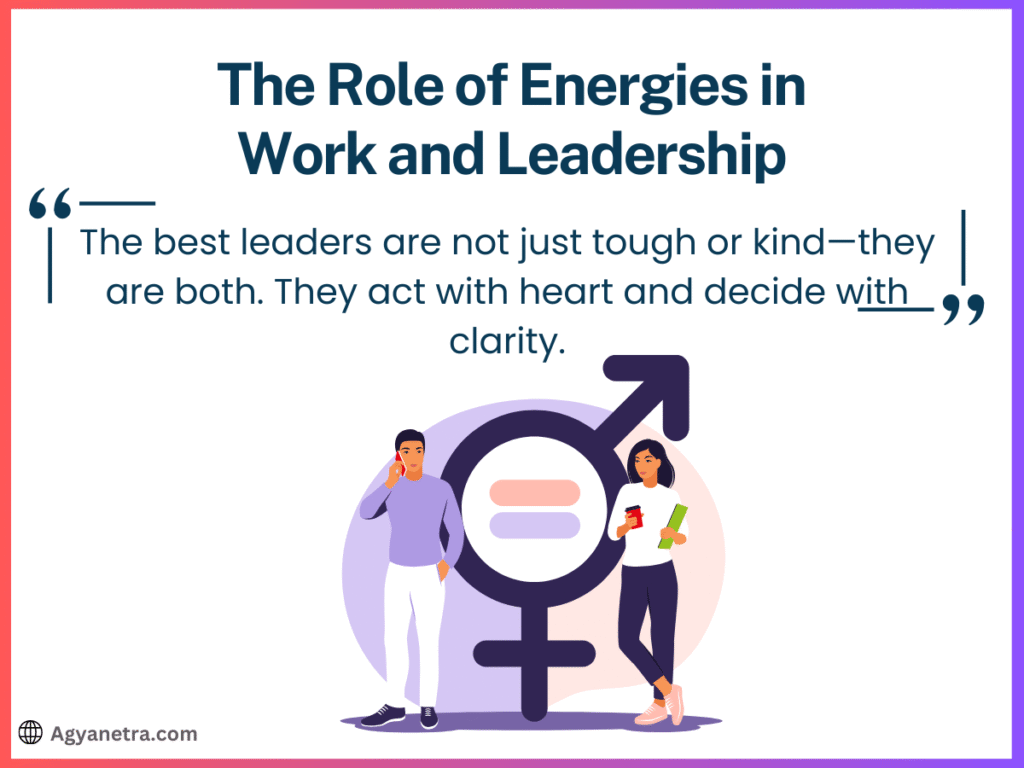Masculine and Feminine Energy Balance is about recognizing that both types of energy exist in every person—regardless of gender—and learning how to use them in harmony.
When you understand how to shift between these energies naturally, you gain more control over your emotions, decisions, and relationships.
Instead of being trapped in rigid gender roles, you start living more freely, with confidence and compassion working together.
Have you ever noticed how some days you’re action-driven and focused, and other days you’re more emotional and connected?
That’s not just mood swings or personality quirks. It’s energy—and it flows naturally within all of us.
This article will help you understand the balance between masculine and feminine energy, how these energies go beyond gender roles, and why learning to recognize and work with them can improve your life, relationships, and leadership. Let’s dive in.
Masculine and Feminine Energy Balance
Masculine and feminine energy are not about being male or female. They are two types of life forces or qualities found in everyone, regardless of gender.

These energies are part of human nature and shape how we think, feel, and act in different situations.
Feminine energy is often connected with qualities like:
- Intuition
- Creativity
- Empathy
- Nurturing
- Emotional depth
- Receptiveness
Think of someone who listens patiently, supports others emotionally, or creates harmony in a group—these are expressions of feminine energy.
Masculine energy, on the other hand, is linked to:
- Action
- Logic
- Structure
- Confidence
- Discipline
- Ambition
Imagine a person who sets goals, organizes tasks, and takes the lead in decision-making—that’s masculine energy in action.
Both of these energies exist in everyone. A woman can have strong masculine energy just as a man can express his feminine energy.
The goal is not to favor one over the other but to learn how to blend them in a way that helps you grow and thrive.
The Problem with Gendered Energy Labels
Many societies have taught us to associate these energies with specific genders. From a young age, boys are told to be tough and independent, while girls are encouraged to be soft and nurturing.

These roles are deeply embedded in our upbringing, education, and media.
As a result, people often feel stuck. A man who wants to express emotions might feel ashamed.
A woman who speaks with authority may be judged as too aggressive. These fixed roles don’t reflect the true nature of our energy. They only limit it.
For example, in many traditional cultures, men are expected to suppress vulnerability and focus on control.
Women are expected to put others first, often sacrificing their own goals and needs. This imbalance creates emotional stress and holds people back from expressing their full selves.
How Masculine and Feminine Energy Works in Real Life
Let’s look at a few simple examples of how these energies show up:

- A parent comforting a crying child shows nurturing (feminine energy), while setting rules about bedtime shows structure and discipline (masculine energy).
- A team leader who creates a project timeline (masculine) but also checks in with team members about how they’re feeling (feminine) is using both energies.
- An artist may tap into feminine energy to create from intuition and imagination but use masculine energy to market their work or meet deadlines.
The most successful and emotionally intelligent people are not those who stick to one side, but those who can switch and balance these energies as needed.
Balancing Energies in Relationships
When one person in a relationship constantly leads, decides, or protects (masculine energy) while the other only supports or nurtures (feminine energy), the relationship can become unbalanced over time.
Healthy relationships allow space for both partners to express both types of energy. A couple might take turns planning (masculine) and emotionally supporting each other (feminine), creating a more equal and satisfying dynamic.
For instance, in a relationship where both partners are working professionals, one might take charge during financial planning, while the other focuses on emotional care during stressful times. The balance isn’t about roles—it’s about awareness and cooperation.
The Role of Energies in Work and Leadership
In the workplace, especially in leadership, masculine energy has long been seen as the default.
Traits like assertiveness, confidence, and decision-making are often celebrated. But what about emotional intelligence, collaboration, and empathy?

These are also powerful leadership traits—just from the feminine energy spectrum.
Leaders who blend these traits tend to inspire more loyalty, reduce conflict, and create healthier teams. For example:
- A manager who makes quick decisions (masculine) but also listens to employee concerns (feminine) earns more trust.
- A business owner who is highly structured (masculine) but also values creativity and flexibility (feminine) creates a culture where people feel valued.
Research supports this too. Teams led by emotionally intelligent leaders perform better because people feel safe, heard, and empowered.
More Posts Like This
- What Is the Power of Male Friendships
- What Is the Power of Female Friendship
- How Hinduism Defines Twin Flames
- How to Balance All Chakras Together
Energies and the Body-Mind Connection
Masculine and feminine energy are not just emotional—they are connected to the body and mind too.
In spiritual traditions like Kundalini yoga, the Ida (feminine, lunar, cooling) and Pingala (masculine, solar, heating) energy channels must be balanced for the body’s energy to rise and awaken full consciousness.
When there’s too much masculine energy, a person may feel stressed, overworked, or rigid.
Too much feminine energy might lead to emotional overwhelm or indecisiveness. A balanced energy flow leads to calm, focus, creativity, and productivity.
Simple practices like breathing exercises, meditation, journaling, or even structured goal-setting can help you tune into and balance your energies.
The Psychology of Energy: Jung’s Anima and Animus
Carl Jung, a famous psychologist, talked about these energies through the concepts of Anima (the feminine side in men) and Animus (the masculine side in women). According to Jung, true psychological health comes when we accept and integrate both.
- A man who embraces his Anima becomes more emotionally open and connected in relationships.
- A woman who accepts her Animus becomes more confident, assertive, and independent.
Denying these energies can lead to imbalance—such as emotional detachment or insecurity. Embracing them allows us to grow into complete, well-rounded people.
Non-Binary and LGBTQ+ Perspectives on Energy Balance
Many non-binary and queer individuals naturally experience both energies without being tied to a fixed gender identity.
Their lived experiences show how masculine and feminine energies can flow freely when not boxed into labels.
This perspective invites everyone to question old gender norms and think of energy as a spectrum.
Whether you’re male, female, or non-binary, you can express both caring and strength, logic and emotion.
It’s not about choosing one energy—it’s about being aware of what you need in a situation and responding from a place of balance and authenticity.
Raising Children Without Energy Stereotypes
One of the most powerful ways to change society’s limited views on energy is by changing how we raise children. Instead of telling boys not to cry or girls to be quiet, we can teach children to:
- Express emotions freely
- Think for themselves
- Respect others’ boundaries
- Show empathy and leadership
When children are allowed to explore their full emotional and energetic range, they grow into adults who are more confident, compassionate, and emotionally healthy.
Final Thoughts
Masculine and feminine energy balance is not just a personal goal—it’s a necessary shift for healthier families, workplaces, and communities.
When we stop tying these energies to gender and start understanding them as human qualities, we open up new possibilities for connection, leadership, and growth.
Whether you are a man learning to embrace vulnerability, a woman stepping into your power, or someone who doesn’t identify with gender labels at all—you have access to both masculine and feminine energy.
These forces are not at war with each other. They are allies. And learning how to balance them brings peace within and around you.
FAQs
What is masculine and feminine energy balance?
Masculine and feminine energy balance means using both action-driven and emotionally aware traits in harmony. It’s about being focused and structured (masculine) while staying kind and intuitive (feminine), no matter your gender.
Why is balancing masculine and feminine energy important?
Balancing these energies helps you lead better, build stronger relationships, and feel more emotionally whole. It creates a life that’s both productive and peaceful, without forcing you into rigid gender roles.
Can men have feminine energy and women have masculine energy?
Yes. Everyone has both energies. A man can be caring and emotional, and a woman can be confident and assertive. It’s about using both sides to live a more complete and authentic life.
How can I tell if my energies are imbalanced?
Signs of imbalance include emotional burnout (too much feminine) or constant stress and control (too much masculine). Feeling stuck, tired, or disconnected may be a signal to rebalance your inner energies.
Is masculine and feminine energy balance related to gender identity?
No. These energies are not tied to gender. People of all identities—male, female, non-binary—experience and express both. It’s a personal and energetic concept, not a gender label.
What are some examples of masculine and feminine energy at work?
A project manager using strategy and deadlines (masculine) while encouraging team feedback (feminine) shows balance. A teacher who plans lessons and supports emotional needs does the same.
How does balancing these energies improve relationships?
It reduces conflict and improves communication. Partners learn to both lead and support, making the relationship more respectful, equal, and emotionally safe for both people.
Can children be raised with balanced energy awareness?
Yes. Teaching kids to express feelings and take action helps them grow emotionally strong and confident. Avoiding gender stereotypes allows children to explore both energies freely.

Vidushi Gupta is an accomplished writer and digital marketing expert with contributions to organizations like Miles Educomp and ICAI. She has authored nearly ten novels and worked as a Senior Content Writer and Digital Marketing Specialist at ESS Global and Shabd. Her Quora posts have amassed almost 20 million views, reflecting her belief in the transformative power of the written word.
